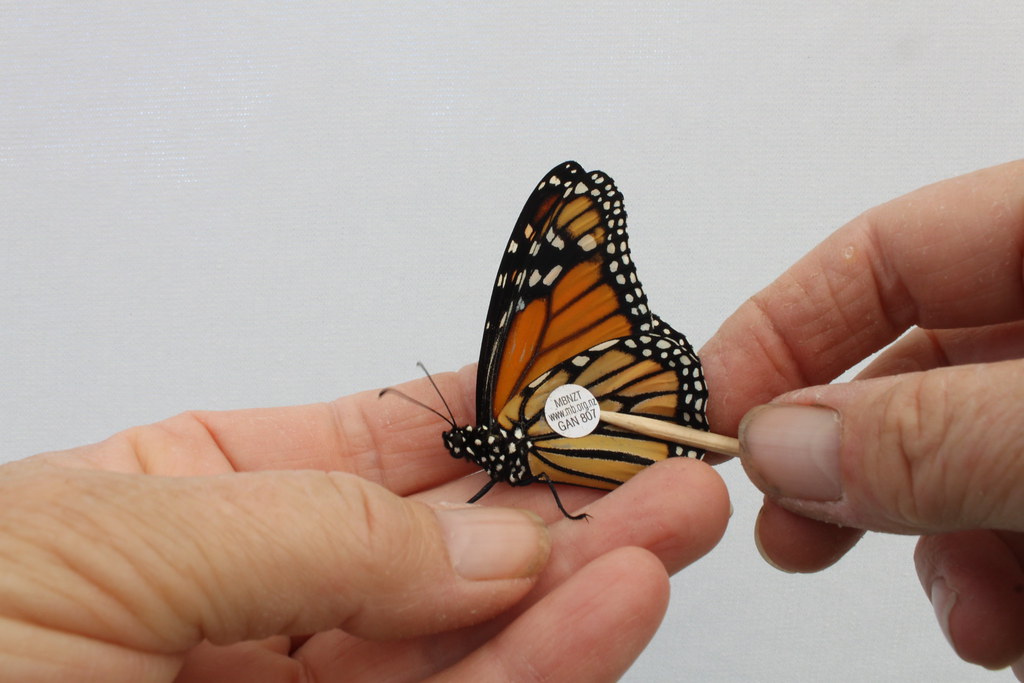 |
| Monarch Butterflies in a fir tree (pendens proditor) |
I'm trying to read as broadly as possible about migration and not just focus on my favorite taxa, birds. Lately I've been reading many many pages about insects and noticed that there are some remarkable parts to insect migration we just don't see in other species.
One BIG difference between bird migration and insect migration is often insect migration is multi-generation. Which means that it takes several generations to make the complete circle of migration.
A prime example of multi-generation migration is the monarch butterfly. Monarchs winter, primarily in Mexico, in huge groups where they cover the fir trees. In the spring they start to move north. Each generation moves a bit farther, lays eggs and then dies, then their young hatch, grow to adulthood, migrate a bit farther and the process repeats until they reach the northern extent of their breeding range (see map). In late summer a special generation of butterflies is born, these will migrate hundreds of miles back to Mexico, all in one big movement. These individuals overwinter in Mexico and then start the process back north the next spring.
 |
| North American Monarch Butterfly Range. (Journey North) |
Insects don't get to take advantage of trial and error during migration. Monarch Butterflies live for only a few weeks and they have never been where they are going. This is their only shot.
Another remarkable thing about migratory insects is there are often differences between generations of a species if one generation is migratory and the next is not. Migratory individuals will have longer more developed wings. Both grasshoppers and locusts have different phenotypes for migratory and non migratory individuals [1]. Change in body shape between generations is remarkable because there is something happening at the genetic level deciding whether or not an individual will be part of the migratory generation. These patterns are well suited to predictable weather environments. For example, if we had an early cold snap in the fall, a non-migratory individual would be ill prepared to south.
Insect migration has been found to be highly influenced by weather patterns. Large scale wind systems, such as prevailing wind systems and fronts move large numbers of insects. Studies show insects are very selected for the wind direction, only leaving on nights when winds are very precisely in the right direction. Following weather patterns makes sense because insects can be easily pushed by the wind. We have a less clear understanding of how smalls scale weather patterns impact insect migration [2].
 |
| Tagging a Monarch Butterfly (Anna Barnett) |
There are many methods used to study the migration of insects, from specialized analysis of radar data [5] to applying tiny numbered stickers to butterflies wings on the breeding grounds (during the late summer) and recapturing them on the wintering grounds. By having monarchs tagged all across the country we are able to track Monarchs across North America and understand how populations from different parts of the U.S. move [6].
The most impressive feat of insect migration I've found is the migration of dragonflies across the Indian Ocean. This round trip flight across the Indian Ocean spans over 14-18 thousand kilometers (8500-11000 miles) [7,8] While assisted by wind, it is still quite impressive. They, like the monarchs take several generations to make their huge journey.
Monarch Butterflies, like many other organisms will start migrating soon. While birds will migrate fairly quickly, just taking a few weeks to make the journey north, butterflies will slowly make their multi-generational way north, moving a few hundred miles and laying the eggs of the next generation. They won't be arriving in the mid latitude states until mid May and the upper Midwest by mid June. If you see Monarchs around your neighborhood this spring, report them here and help us better understand how these remarkable critters are moving across the continent. Spring will get here eventually, so keep your eyes peeled!
~~~~~~~~~~~~~~~~~~~~~~~~~~~~~~~~~~~~~
On a non-migration related note, today I read about hornets and how they defend their hives from other insect invaders by surrounding the invader and vibrating their thoraxes to create so much heat that the intruder DIES! Nature is so cool sometimes.
- Auriel
~~~~~~~~~~~~~~~~~~~~~~~~~~~~~~~~~~~~~
Citations
[1] Denno, R.F. (1994) The evolution of dispersal polymorphism in insects: the influence of habitats, host plants and mates. Researches on Population Ecology 36, 127–135.
[2] http://www.annualreviews.org/doi/pdf/10.1146/annurev.en.33.010188.001151
[3] Hyatt, M. (1993) The use of sky polarization for migratory orientation by monarch butterflies. PhD thesis, University of Pittsburgh, Pittsburgh, Pennsylvania.
[4] Baker, R.R. (1987) Integrated use of moon and magnetic compasses by the heart-and-dart moth, Agrotis exclamationis. Animal Behaviour 35, 94–101.
[5] http://bioscience.oxfordjournals.org/content/53/5/503.short
[6] http://monarchwatch.org/tagmig/fallmap.htm
[7] Anderson, RC (2009). "Do dragonflies migrate across the western Indian Ocean?".Journal of Tropical Ecology 25: 347–348.
[8] http://news.bbc.co.uk/earth/hi/earth_news/newsid_8149000/8149714.stm
No comments:
Post a Comment